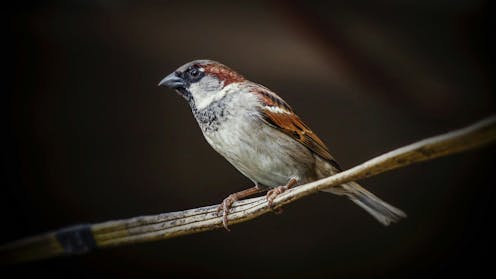
Living in cities exposes people to all sorts of chemical pollutants. Many are harmful even at low concentrations . But it is hard to know what the risks and consequences might be.
Authors
- Simon Griffith
Professor of Avian Behavioural Ecology, Macquarie University
- Mark Patrick Taylor
Honorary Professor, School of Natural Sciences, Macquarie University
- Max M Gillings
PhD Candidate, School of Natural Sciences, Macquarie University
The animals we share our cities with can indicate potential sources and effects of such pollution. In this way, they act as sentinels - just like the canary in the coalmine, used to alert underground miners to the presence of dangerous levels of toxic gases in the 19th century.
Our research on house sparrows in three Australian towns revealed subtle but disturbing effects of pollution on these birds.
In the mining town of Broken Hill, New South Wales, sparrows suffered from exposure to lead in areas where thousands of people live. Similarly, in Portland, Victoria and George Town, Tasmania, sparrows living near aluminium smelters were affected by the smelting byproduct fluoride. The results suggest the health and wellbeing of city people may also be at risk.
Anxiety: aversion to the human gaze
Sparrows have lived alongside people for thousands of years . In that time they have picked up useful skills, such as feeding off food scraps, while avoiding harm.
Most people are familiar with the sight of a sparrow boldly feeding from leftover food at a café, even indoors. If the birds are ignored they often feed within arm's length. But as soon as someone looks directly at them, they fly away and become very wary.
This is one of the sparrow's super skills, allowing them to thrive in the urban environment. People mostly ignore them and cause them no harm. But if a person is focused on them, they respond as if they suspect something bad might happen.
Sensitivity to the human gaze is well studied in human psychology. It has also been shown in urban gulls that steal food in Europe.

We explored the effects of lead pollution on sparrow gaze sensitivity in Broken Hill.
Sparrows have small home ranges (about 300 metres). We established enclosed feeding stations at four sites across the city. We also tagged each bird and measured the amount of lead in their blood.
Then we erected boards with a photograph of a man either looking directly at the feeding station, or to the side. We presented different pictures over several days. Our results showed a clear distinction between responses to the images.
Sparrows flocked to the feeding stations. But they took much longer to visit the feeder when the man in the picture appeared to be looking at them. Those living in areas with high lead levels were especially sensitive to the direction of gaze.
Video recordings of sparrows revealed those with high levels of lead in their blood were more anxious. They spent more time looking up and checking for predators than sparrows in areas where lead pollution levels were relatively low.
Anxiety is a common symptom of lead poisoning in people . It is caused by damage to the nervous system during development.
Our research showed sparrows living in contaminated areas of Broken Hill were more anxious. This would help reduce the risk of being caught by a predator. But there are downsides to being an anxious sparrow, not least because less time is spent feeding.
Another common consequence of lead poisoning is impaired mobility. When we analysed video recordings of sparrow escape flight, we found sparrows with high blood lead levels were slower to take off. Every second counts when being attacked by a sparrowhawk or cat.
Longevity: checking chromosomes for ageing
The length of the "telomeres" - caps that prevent chromosomes from damage - has proven to be a good marker of how long an individual will live.
When we measured telomere length in the sparrows across Broken Hill, we discovered sparrows with higher levels of lead in their blood had shorter telomeres . Generally, birds with shorter telomeres die at a younger age.
Previous studies of humans exposed to lead through industrial occupations also found telomere shortening .
Brittle bones and pitted teeth
We also studied sparrows in two towns near aluminium smelters : Portland, Victoria and George Town, Tasmania.
Fluoride is a major byproduct of aluminium smelting . After fluoride is emitted into the air it falls back to Earth where it can contaminate land, water and plants. So animals may breathe it in, drink contaminated water or eat contaminated food. Fluoride then accumulates in the animal's bones and teeth.
Earlier studies found high exposure to fluoride deposited around the Portland aluminium smelter caused bone lesions in nearby kangaroos and dental problems in koalas .
We found sparrows living up to 10km from these smelters had unnaturally high fluoride levels in their bones.
Excess fluoride uptake changes the balance of the essential bone minerals, calcium and phosphorus. These minerals play an important role in bone structure. Changes in their composition could compromise bone strength, with implications for activities such as flight.

Heed the lessons
Pollution affects virtually all aspects of life - from how organisms behave to how they age and grow. The health of the environment, animals and people are tightly intertwined .
Further, in light of strengthening evidence that even low levels of lead and fluoride exposure might be harmful at times, reviewing environmental management controls and pollution limits is warranted.
We should heed the lessons of sentinels such as the sparrow, and reduce pollution at the source. This will benefit urban ecosystems and, in turn, the health and wellbeing of humans.
![]()
Simon Griffith receives funding from The Australian Research Council
Mark Patrick Taylor has received funding from The Australian Research Council. He has also previously received funding from New South Wales Environment Protection Authority (EPA) for research into environmental lead and human health implications at Broken Hill, NSW. He was also a former full-time employee of EPA Victoria, appointed to the statutory role of Chief Environmental Scientist.
Max M Gillings is involved in research affiliated with and funded by EPA Victoria.






